Photo by Phill Magakoe/AFP
Youth Day 2022: Forging resilience for a sustainable future
Young South Africans must forge resilience to contribute to a better and more sustainable future for all. This is the message this Youth Month, as the country commemorates the Soweto student uprisings that began on 16 June 1976. It has been 46 years since hundreds of young black learners were killed by apartheid forces for protesting the imposition of Afrikaans as a medium of instruction in schools. Youth Day honours young South Africans’ struggle for liberation and celebrates those who are forging ahead to ensure that the dream of a better South Africa becomes a reality.
The South African government announced the 2022 theme of “Promoting sustainable livelihood and resilience of young people for a better tomorrow”. Minister in the Presidency Mondli Gungubele says the government acknowledges and appreciates the contributions that young people are making towards the advancement of the country, despite challenges such as unemployment, gender-based violence and substance abuse. “The youth are the future of this country and therefore the government remains resolute in creating a favourable and supportive environment for the youth to become successful entrepreneurs and leaders.”
According to StatsSA, youth in South Africa continue to be disadvantaged in the labour market, irrespective of education levels, with an unemployment rate far higher than the national average. In the first quarter of 2022 the unemployment rate rose to 63.9% for those between the ages of 15 and 24, while the unemployment rate for the 25-34 age group stands at 42.1%.
Experts agree that although factors such as population growth, lack of experience, inappropriate job-seeking techniques and a lack of career guidance in schools do play a part, the unemployment rate for first-time job-seekers in South Africa is unacceptably high.
As the country prepares to celebrate National Youth Day and Youth Month, the focus will be around development and empowerment initiatives to support young people. Using the multi-sector action plans of the Presidential Youth Unemployment Intervention and the Youth Employment Stimulus, the government hopes to draw more people into the economy through a range of formal education and training programmes, learnerships and internships, as well as providing support for youth entrepreneurs.
But this is not enough. In order for young people to truly contribute to a better and more sustainable future, intervention is needed from individuals, corporations and institutions across the board.
Gungubele says it is also up to young people to step into the future they want: “The youth of 2022 is called upon to help us build a better tomorrow for everyone. Young people, become agents of change, embrace the opportunities provided and rise to the challenge of leading South Africa’s post-Covid-19 recovery.” — Jamaine Krige
——————————————————————————————————————————————————————————————–
Uplift and empower: Connecting world-class mentors to future leaders
Guidance and mentorship are key if the youth of today are to become the leaders of tomorrow. This is according to MTN Executive and Founder of the Mentorship Boardroom, Yolanda Cuba. “We are in a position of privilege, and with privilege comes responsibility,” she explains. “We want the next generation to be better than the current generation, and that will only happen if we, as the prevailing leaders of industry and society, pay it forward by uplifting and empowering others.”
 Yolande Cuba, MTN Executive and Founder of the Mentorship Boardroom
Yolande Cuba, MTN Executive and Founder of the Mentorship Boardroom
The Mentorship Boardroom was launched on Mandela Day 2021, when Cuba drew in almost 100 industry leaders and big business bosses to offer 67 minutes of mentorship to people across the country. “The idea was to connect South Africa’s trailblazers to individuals who would never have had access to them under normal circumstances,” she explains. “We had CEOs, the chairpersons of JSE-listed companies, successful entertainers and media personalities, business executives and entrepreneurs — the response was overwhelming!”
Since then, the Mentorship Boardroom has grown from strength to strength, with an aim to reach over one million people across the continent. This Youth Day more than 200 unemployed graduates between the ages of 21 and 35 were given the opportunity to learn from the best, including entrepreneurs, brand specialists, HR experts, marketing gurus, career coaches and performance management experts. These world-class industry leaders offered practical workshops and group mentorship to provide motivation, inspiration and the tools needed to soar to new heights.
More than anything, says Cuba, the right mentor can provide a sense of hope: “I remember thinking one day how much I had benefited from the mentors and sponsors who had given me a new perspective, a new sense of hope, and ignited something in me that set me off on my path to success, and I wanted to help others regain that hope and ignite that dream that they have.”
She says it can be tough if you want to be a neurologist but have never had a conversation with someone in that field; becoming a pilot may seem a remote dream for someone who has never set foot on a plane. “This platform is really built to allow for people who actually have the capabilities, who have done it before, to share their time and their expertise with the younger generation, in order to build better leaders for Africa.”
The platform allows mentors to sign up and specify when they are available for sessions, and aspiring mentees can then apply for an appointment with their preferred mentor. “In doing so we make mentorship tangible and give hope by connecting them to opportunities to speak to people who can offer real-world wisdom and advice,” she says. “The second thing we do is to look at what frequent challenges the youth face when it comes to employment and their careers, and then create sessions based on that.”
One of the key issues that comes up in sessions is how to stand out from the crowd. To address this, the Mentorship Boardroom approached one of Africa’s top brand managers to share knowledge and skills about personal and professional branding and how they impact on employment opportunities. “We got such great feedback from people, saying how awesome it was that the training was so practical, because they left with a toolkit or a reference model that they could put to use going forward.”
Cuba is passionate about empowering women, because she knows that their upliftment is directly tied to the betterment of society. “We are deliberate in our focus, and aim to ensure that 70% of people who benefit from the work we do are women, especially young women.”
This is also why representation matters: “If I look at a job I aspire to and see someone who looks like me, someone who talks like me, someone who is from a similar background, it makes my aspirations seem possible. Seeing someone who is similar to us helps us bridge the gap between dreaming and believing.”
Choosing the right mentor for you
Despite this, she says, some of her most impactful mentors have been people with vastly different backgrounds and contexts from her own. “It’s not always about race or gender or anything else,” she explains. “It is, however, about who you want to be and who inspires you.”
There is no one-size-fits-all solution when it comes to mentorship, and many successful people will admit that they have had multiple mentors at different stages of their career or for different things in their life simultaneously. When choosing a mentor, she has the following advice: “Look for someone who inspires you in some way. Look for someone who is genuinely interested in your outcomes, because if they aren’t then you’re not going to gain much from the relationship. A good mentor will be interested in you and your progress, because they will see you as tomorrow’s leader. Thirdly, you must be able to communicate openly with your mentor and establish a relationship of trust and transparency in your interactions.”
The one thing Cuba wishes young people knew is this: “You are the one standing in the way of your own success. Sometimes fear gets in the way, sometimes it is something else. Sometimes it is something you do, but more often than not it is the things you don’t do, and the chances you don’t take. It’s the doors you do not open, and the doors you refuse to even knock on.”
She recalls an earlier point in her career, where she was undergoing a career transition. “I phoned a CEO who I had never met out of the blue, and that eventually led to them creating a position for me. If I had waited for a job listing or a vacancy posting to appear, then that would never have happened,” she says.
As for the current generation of leaders, there is one thing she wishes they would remember: “As South Africans, we have had the privilege of benefiting from policies that have changed in our lifetimes. And with that privilege — the privilege of being the first generation — we have a responsibility to ensure that those benefits do not end with us. We have a responsibility to build a sustainable South Africa that is based on everyone’s full participation. If we can inspire every leader to take up this call, then it will make it easier for the next generation, and the generation after that. If we fail our young people, however, then that will be on us, and on our consciences.” — Jamaine Krige
——————————————————————————————————————————————————————————————–
Binneplaas: Bigger than farming, more than a brand
Binneplaas started as a township clothing brand to inspire a sense of pride in the youth of Suurbekom, and has since grown into a booming food-supply chain that uplifts the community and creates opportunities within the agriculture sector. Its 36-year-old Founder, Bonginkosi Radebe, told the Mail & Guardian how the West Rand initiative is changing the narrative about farming and agriculture among young people in the area.
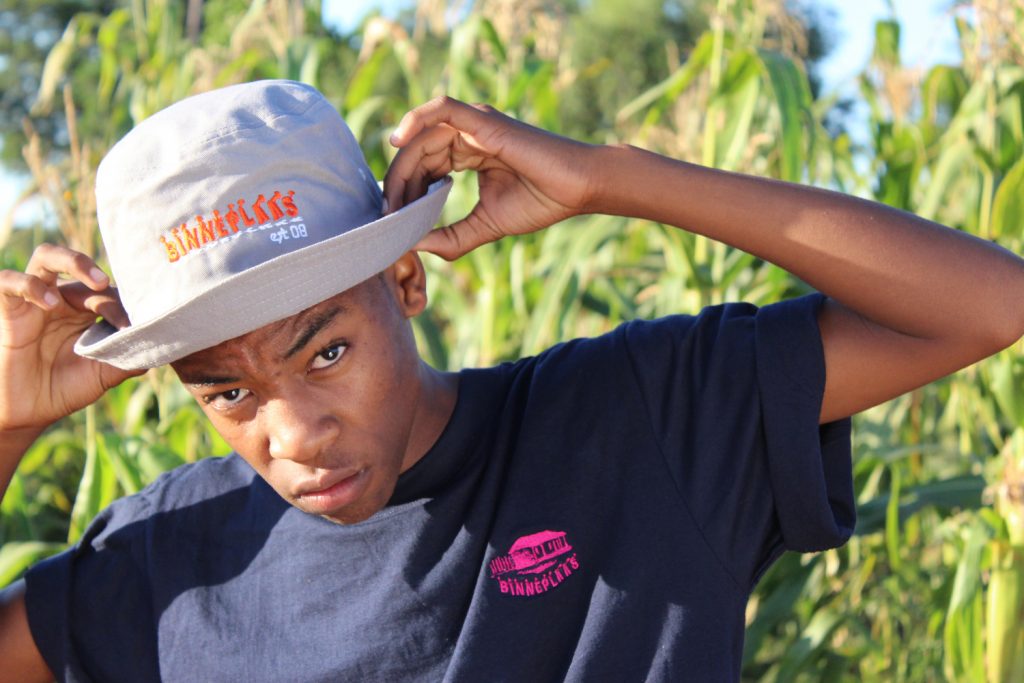 Binneplaas began as a clothing brand before it expanded to include farming.
Binneplaas began as a clothing brand before it expanded to include farming.
Today, Binneplaas employs a branding-packaging-distribution model for a variety of farm products, catering to informal markets but also to the elderly in the community. “We close the gap between the farmer and the consumer or buyer, making fresh produce more accessible to everyone,” Radebe says. “We also assist in garden start-up programmes and offer free consultations to up-and-coming young farmers and youth who are interested in getting involved in agriculture.”
Currently the focus is on crop and poultry farming, but Radebe looks forward to extending its reach and expanding the offerings available: “I have also created a market for the brand in the informal sector as a supplier for fresh vegetables, and we use some of the youth of Suurbekom and its neighbouring townships to assist us with sales in their respective locations. We supply vendors in and around the West Rand and also cater to some homes in Soweto.”
Binneplaas procures goods from local farms and helps unemployed people between the ages of 18 and 35 to sell these products, thereby creating an income stream for them. While a youth-driven initiative, Radebe says that young people are not the only ones who benefit. “Some of the farmers we use as our vegetable suppliers are pensioners who struggle to sell and market their goods themselves. We have, therefore, committed ourselves to assist them and ensure that they can still earn something and that their produce does not go to waste.” In doing so, the project helps to combat poverty and reduce hunger.
From humble beginnings
Radebe says the initiative started in 2016 as a platform to amplify the voices of the youth of Suurbekom township on Gauteng’s West Rand. It was a time when morale was low and there did not seem to be much cause for pride and celebration. “Our neighbouring townships were doing things to put themselves on the map, and it seemed like we didn’t have much to boast about,” he explains. “A few friends and I decided that we would create a clothing brand that represented us and where we come from, which we could wear with pride.”
With his background in graphic design, Radebe created the first items of the clothing line: “The rationale was to create a brand that we could be proud of, as well as an opportunity to promote our township, since most neighbouring ones considered Suurbekom to be a farm,” he remembers. “Many people called Suurbekom ‘Binneplaas’ as a way of looking down on us in our ‘farm-like’ environment. We therefore decided to use the word to uplift our home instead of using it against ourselves.” The brand gained traction among the youth of Suurbekom before spreading to other areas.
After the initial hype died down, so did the support for the brand. Despite this, Radebe did not give up on his dreams. Instead he decided to expand them: “In 2019 when I lost my full-time employment as an IT desktop support technician, I took my UIF payout and decided to formalise Binneplaas and register the brand.”
By the time Binneplaas made a comeback, the challenges around identity and employment among Suurbekom’s youth had intensified. Radebe says people were hungry: “This was when we decided to relook at what Binneplaas was, and reintroduce it as a lifestyle and not just a brand. We were now set on promoting the agricultural lifestyle and making farming fashionable, and we knew that to succeed we needed to find youth who embodied that, or help foster youth who would.”
In the same year, he started a sweet potato garden to keep himself busy while job hunting. The garden produced such a successful yield that Radebe decided to sell the excess to the people around him. “Almost half a hectare of sweet potato was sold that year to homes in neighbouring locations. This was when I discovered that there was a huge market for produce in the informal sector, and this was the start of our distribution channel.”
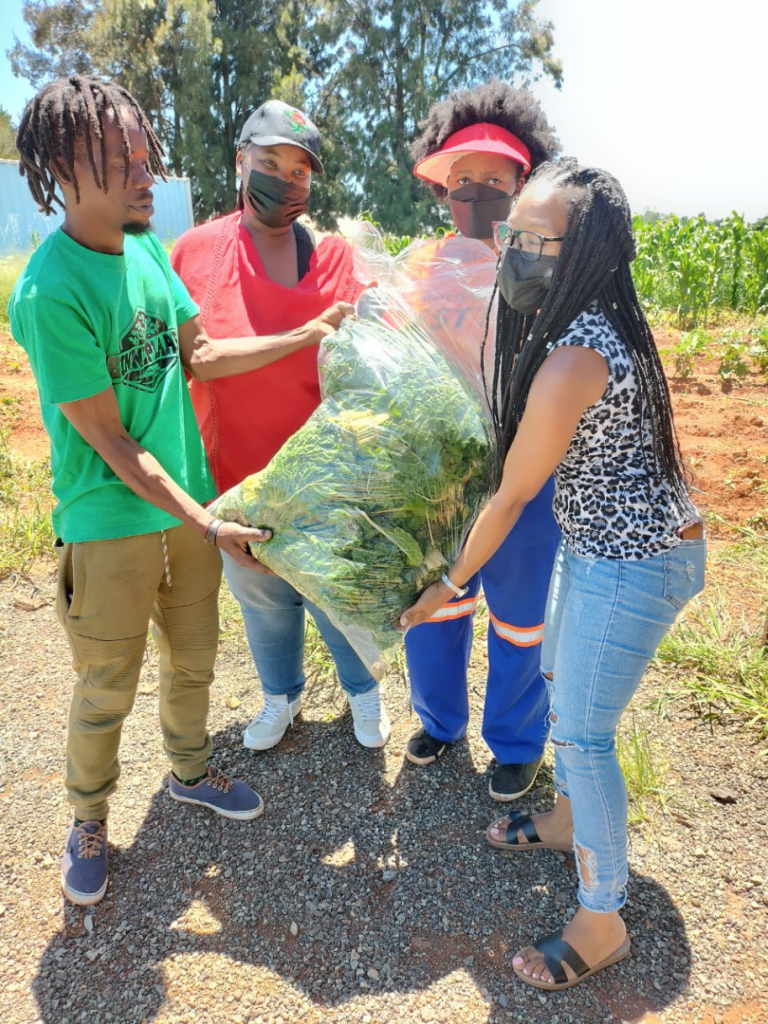 Binneplaas operations include crop and poultry farming. It caters to the informal market and incorporates and trains youths in its operations.
Binneplaas operations include crop and poultry farming. It caters to the informal market and incorporates and trains youths in its operations.
In 2021, Radebe decided to formalise his career in agriculture by attending a training course in crop and poultry farming. All the while, his sweet potato enterprise was growing: “One day my seven-year-old son joined me in the garden while I was busy planting. I suddenly realised that children and young people could benefit from learning how to plant their own vegetables, for commercial purposes but also for personal use.”
Changing narratives
It’s unusual for a township initiative like this to have an Afrikaans name, but Radebe says this was a decision that was made with intent. “Directly translated, it means inside a farm, or within a farming boundary; when used in the township, it is a slang term referring to someone who does not travel much,” he laughs. “This is someone who always shouts ‘local is lekker’ and finds comfort in being home.”
Both of these meanings celebrate what Binneplaas is about, and aim to change existing narratives about farming in South Africa: “Most farm owners that we grew up seeing in the media have been middle-aged white men, but we challenge this narrative. We work with elderly farmers, usually black women, and with the youth.”
The clothing brand itself also strays away from the traditional two-toned khaki looks associated with the agriculture sector. “The current style of the clothing brand is durable casual wear that allows for outdoor activities, such as farming, camping, fishing and hiking,” he says. “We worked towards creating clothing that can be worn when you visit the mall, but also when you’re digging in the garden.”
The profits from the clothing sales are used to support other initiatives associated with the Binneplaas lifestyle.
This is important to change the perception among young people, especially those in a more urban environment. “Most black youth see farming as a job, but it is about so much more,” Radebe explains. “We want them to educate themselves about the benefits of farming as therapy, and to understand the importance of the sector as a basis for food security. If more young people could comprehend that agriculture is the one industry that will always be with us and never die out, then they would invest more time and skills into it.”
If children could start learning about agriculture and farming at school level, it would also alleviate problems such as hunger and poverty-driven crime. “We need to reprogramme ourselves as young people to stop saying that we need funding. Instead, we need opportunities, because opportunities create purpose. There are so many resources available to help create these opportunities, like Youtube, Google, government initiatives, incubation hubs and skills development agencies … the list goes on! Young people need to get out there and find these opportunities, because they won’t find you while you’re sitting on your couch.
“We as the youth are not lazy and we are not unmotivated,” he explains. “We are just uninformed and incorrectly programmed … but we can change that.”
More than just planting seeds
Radebe says young people must stop competing with each other and start collaborating. “Few things are ever achieved when working alone, and at Binneplaas we work hand-in-hand with interested youth to get them into farming and create a supply chain that they can be a part of,” he says.
“Our educational model involves teaching people that agriculture is about more than just putting seeds in the ground and watering them. Someone needs to sell the produce, someone needs to market it, and these are different functions that are strenuous when one person tries to take it all upon themselves.”
And if the opportunities do not exist, he says, then young people must create them: “Agriculture as an industry is very broad, and we need to educate the youth so that they stop thinking of it as farming only.
“Farming is just one part of agriculture, and it does not stop there. There is an entire supply chain that the youth can benefit from! A proper understanding of the farm-to-table concept would bring so much growth in these youth operations, and contribute towards food security throughout the country, Africa and the world at large.” — Jamaine Krige
——————————————————————————————————————————————————————————————–
Yes4Youth: Private-public partnerships to grow youth career opportunities
Investing in the youth not only empowers young people; it uplifts families and communities and benefits South Africa at large. But, says Bridgestone Southern Africa’s Head of Talent, Botaki Hlalele, this is no mean feat, and cannot be achieved by government alone, or by corporates working in isolation.
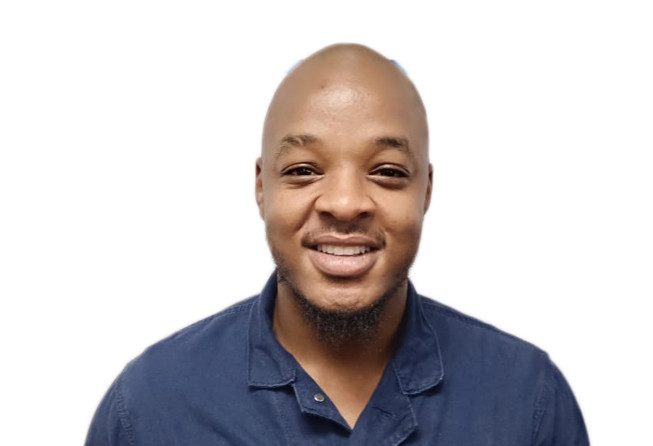
Ayanda Letsapa, Shift Engineer at Bridgestone Southern Africa
This is why Bridgestone Southern Africa has partnered with the Yes4Youth programme to help young people grow their careers and shape their futures. “There will be no magic wand with the government working alone. We have a responsibility to shape the kind of future that we envisage, build capability and give people their self-worth. That future is not created by being bystanders,” Hlalele says.
Companies have the means and opportunity that the public institutions may not have, and vice versa. “While the government creates a conducive environment, organisations are able to accommodate and expose youth to best learning experiences; Yes4Youth is a case in point.”
Yes4Youth is a business-led collaboration that partners with government and labour to tackle the country’s unemployment challenge. Bridgestone Southern Africa’s graduate development programme has been partnering with the Yes4Youth programme since 2020; 151 graduates and diplomates have already received a comprehensive internship to ready them for the world of work. But Bridgestone’s proudest boast, says Hlalele, is that it has managed to place 42 of them in permanent positions within the company.
The programme develops youth in the skills that are at the core of the company’s future sustainability, such as engineering, finance, sales and IT. “This helps with developing a pipeline from which the company can draw when vacancies arise,” Hlalele explains. “A company like Bridgestone benefits by also building youth who understand the culture of the organisation, and not just the skills required.”
In doing so, he says, everyone wins: “The economy wins because one youth taken off the streets is a great plus for the country, and the skills we bring onboard reflect what the country requires from a critical skills perspective. We are committed to supporting the government’s drive to reduce unemployment by providing the work experience the youth need to stand out in the competitive jobs market.”

Ephodia Makwala, Human Resources Manager at Bridgestone Southern Africa
While good for the country, this also has an immense impact on the individuals within the programme: “The future of this country is the youth, and we cannot ignore such a reality. We have to invest in our youth now if we are to make a difference tomorrow. I have noticed the meaning that these opportunities have for the youth and their loved ones. As an organisation, we do not only have a responsibility to the youth — directly and indirectly we impact families in the most positive way, by affording youth the opportunity to make a difference in their lives.”
Success stories
Ayanda Edwin Letsapa is an engineering graduate from Sebokeng and was appointed as a Maintenance Planner in September 2021. He has since been promoted to Shift Engineer. He says since landing the job at Bridgestone, he has been given the opportunity to better himself, improving on his technical and communication skills. “Above all, I am gaining more confidence in the engineering and operations field; I am more driven, and have developed a positive attitude.”
Limpopo-born Risuna Mabasa is a Logistics and Supply Chain graduate and is now a planning analyst at Bridgestone’s Brits manufacturing facility. “I have learned that, just like in any organisation, you need to have good relations with people,” she says.
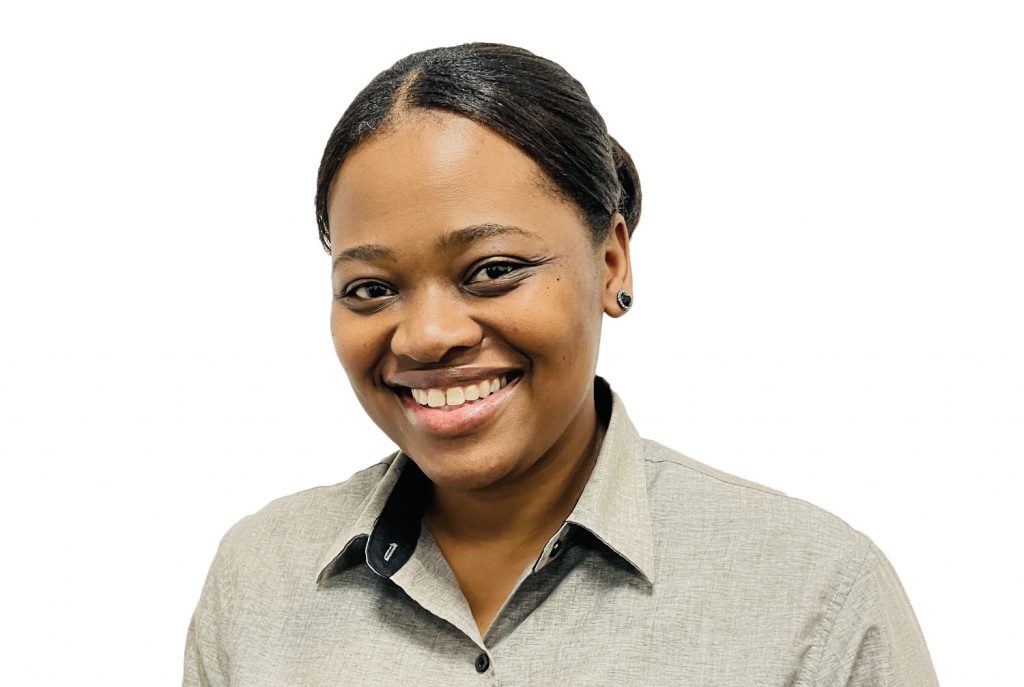
Risuna Mabasa, Planning Analyst at Bridgestone Southern Africa
Ephodia Mokwala, also from Limpopo, is building a career in HR. Since gaining permanent employment, she says she has been given more autonomy and can initiate projects and processes. As a result, she has become better at working on her own and is developing her business acumen.
These young workers acknowledge that the Yes4Youth programme opened doors for them. Mokwala’s advice to other interns is to cultivate a professional approach and perform each task well: “Always seek feedback so you know what to improve on.” Mabasa agrees: “Let your work speak for itself.”
Letsapa says interns should concentrate on learning how to perform the basic tasks in the departments where they are placed, as this lays the foundation for further advancement. It also means the intern is in a position to engage with his or her superiors on a professional level. “If you are seen to add value to the business, you are much more likely to be offered a permanent position. Always remember: your superiors are not responsible for your career — you are!” — Jamaine Krige
——————————————————————————————————————————————————————————————–
CSIR in the business of developing a strong SET pipeline
The Council for Scientific and Industrial Research (CSIR), an entity of the Department of Science and Innovation, continues to invest in the development of young people and assist them to take advantage of the opportunities presented by the digital economy. During this Youth Month, the CSIR is reflecting on the impact of its intervention programmes and its contributions towards meaningful growth and development opportunities for young researchers in science, engineering and technology (SET).
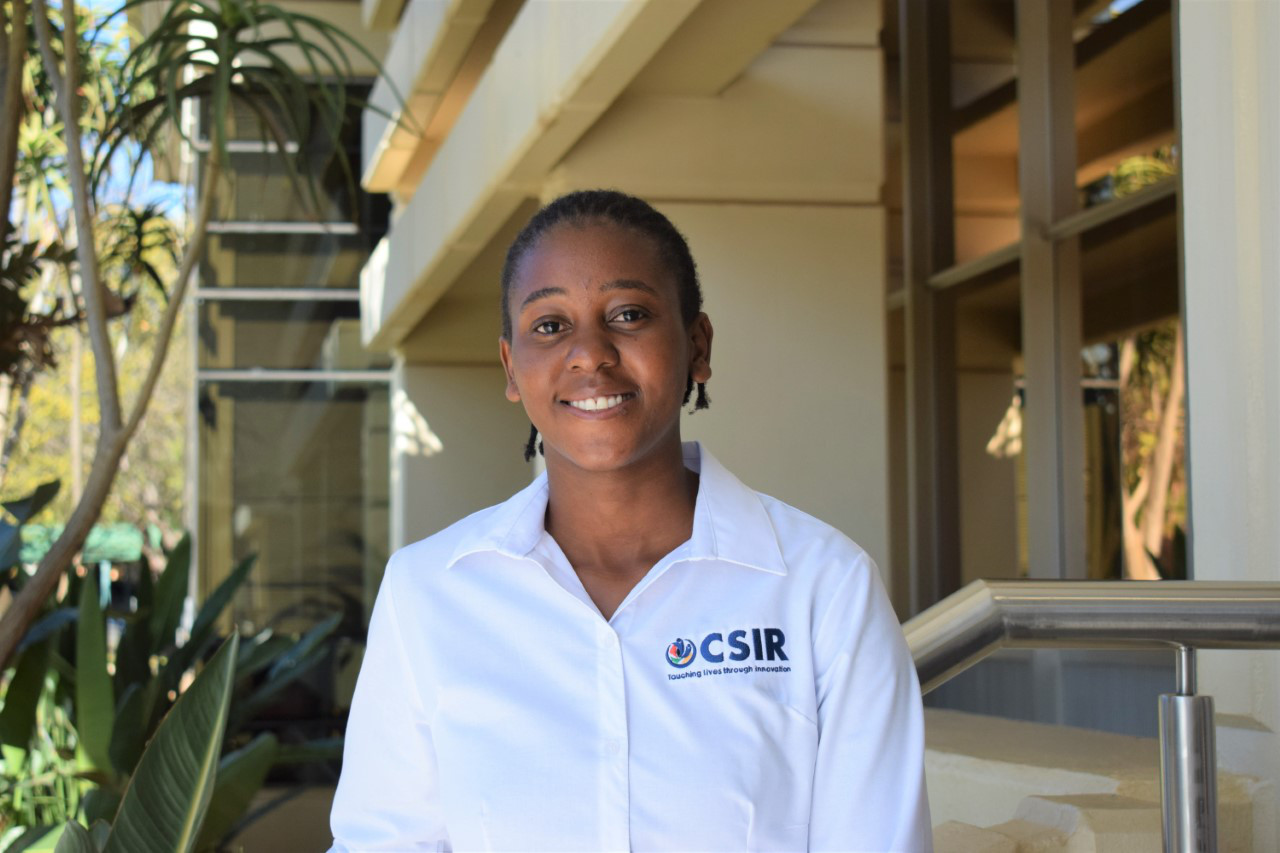 Tina Chunga (28), a beneficiary of the GIT programme
Tina Chunga (28), a beneficiary of the GIT programme
The CSIR is Africa’s largest science organisation, and its workforce consists of about 40% of young people from multidisciplinary fields, reflecting the organisation’s commitment to the development of a strong SET pipeline to contribute towards building the country’s knowledge economy as we transition to the fourth industrial revolution.
The CSIR implements various programmes to upskill the youth and combat youth unemployment. Some of these programmes include the CSIR bursary programme, Graduates in Training (GIT), Youth Employment Service (YES) programme, the biennial Emerging Researchers Symposium (ERS), the Youth Forum and various science outreach initiatives.
 Justin Harrison (30), one of the beneficiaries of the CSIR bursary
Justin Harrison (30), one of the beneficiaries of the CSIR bursary
During the 2021 academic year, the CSIR bursary programme funded a total of 86 students. One of the beneficiaries of the bursary is Justin Harrison, 30, a doctoral student from the University of the Witwatersrand working at the CSIR’s Photonics Centre. His research focuses on laser beam shaping and amplification for high-power applications such as additive manufacturing, cutting and welding.
The GIT programme, on the other hand, focuses on developing graduates with relevant skills as part of work readiness training. The programme offers rotational work experience, assisting graduates towards their professional registration with recognised professional bodies. Through this initiative, the CSIR has recruited 80 candidates. One of the graduates currently benefiting from this programme is Tina Chunga, 28, who is a process engineer in the Agro-processing Research Group at the CSIR. She holds an Honours Degree in Chemical Engineering and is a registered candidate engineer with the Engineering Council of South Africa. Her research interests are in processing, analytical and quality assurance methods in the production of pharmaceuticals, cosmetics and essential oils.
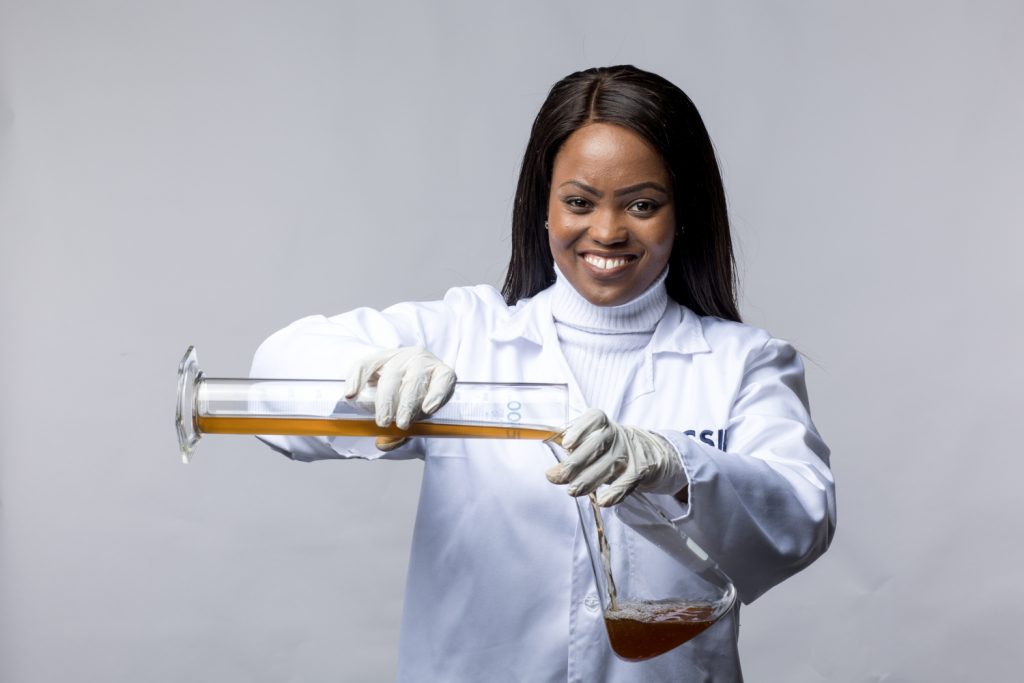 Wandisa Chesane (28), a candidate placed at the CSIR under the YES programme
Wandisa Chesane (28), a candidate placed at the CSIR under the YES programme
As part of equipping young people with much-needed skills, the CSIR, in collaboration with the YES programme, has appointed 55 unemployed youth for a period of 12 months who are placed at the CSIR and its partnering small and medium-sized enterprises. One of the candidates currently placed at the CSIR is Wandisa Chesane, 28, who is a BTech (Chemical Engineering) graduate from the Vaal University of Technology. She is currently studying towards a Master of Technology in Chemical Engineering. She has a passion for using software for process design, modelling and the simulation of chemical engineering to drive strategic research and development.
As part of developing the next generation of established researchers, the CSIR will host the ERS, a platform that provides emerging researchers with the opportunity to network, present and exhibit their research work. This year’s ERS will be held under the theme “Innovation in entrepreneurship” at the CSIR ICC in Pretoria on 12 and 13 July.
For more information, visit www.csir.co.za
or [email protected].
To view this supplement in PDF format, visit:
https://mg.co.za/wp-content/uploads/2022/06/9a83167e-2022-06-17-youth-day.pdf